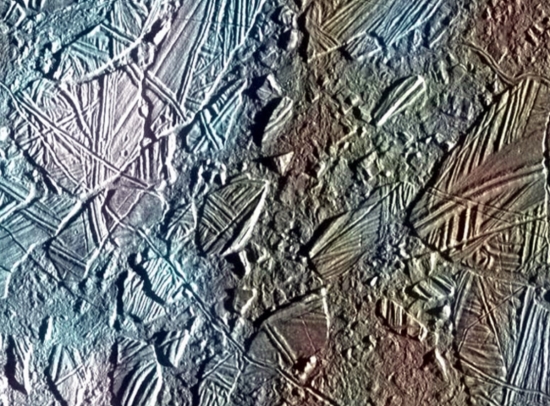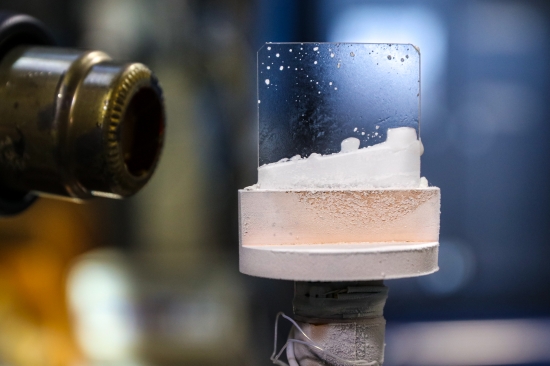The first thing to say about the image below is that it fills me with anticipation for the imagery that Europa Clipper will acquire when it travels to the Jovian moon later this decade (arrival in 2030, according to current planning). This is a Galileo image taken in 1996, the subject of intense study, as have been all the Europa images, ever since. How much interaction does Europa’s subsurface ocean have with the icy crust? We can’t say for sure how much is going on now, but images like these show how much fracturing and re-formation there has been in the past. In any event, fresh data from Europa Clipper should give us entirely new insights.

Image: Enhanced image of a small region of the thin, disrupted ice crust on Jupiter’s moon Europa taken in 1996 by NASA’s Galileo spacecraft. Image Source: NASA.
Beyond that, though, there is another story with Europa implications that is being investigated by scientists at Oak Ridge National Laboratory, an installation under the aegis of the U.S. Department of Energy. Because while we can look at the above image and discuss plumes coming up from beneath (and there is some evidence for this), we also have to remember that this may be a different kind of ice than we find occurring on Earth. What we see on Europa and other icy objects in the outer system likely comes under the heading amorphous ice.
The distinction occurs because ice in a cold, hard vacuum shows an atomic structure that is not arranged into a tight crystalline lattice. Somewhere along the line water ice makes a transition between crystalline and amorphous ice phases. Just how this occurs is difficult to observe, but scientists at ORNL, working with colleagues at the Jet Propulsion Laboratory, have been able to lower the temperature of a crystal sapphire plate to 25 K, after which it was placed in a vacuum chamber, where a small number of heavy water molecules (D2O) were added.
The idea was to observe changes in the ice structure with temperature, with plans to simulate outer Solar System conditions by bombarding the sample with electron radiation and charting the effect on the ice structure. Chris Tulk is an ORNL physicist specializing in neutron scattering:
“The experiment produced a layer of amorphous ice similar to the ice that makes up most of the water throughout the universe. This is the same type of ice that could have formed on the extremely cold permanently shadowed regions of the Moon, on the polar regions of Jupiter’s moon Europa, and within the material between the stars in our galaxy, known as dense molecular clouds. Although much of the ice has by now probably crystallized on the warmer bodies, the fresh ice on colder bodies and in deep space is likely still amorphous.”
We know that Europa’s surface is constantly irradiated by charged particles coming off interactions with Jupiter’s intense magnetic field. Just how the ice is changed — and how much of the surface ice turns out to be amorphous — will be factors as we analyze data from Europa Clipper. The laboratory work is also applicable to likely amorphous ices in the Kuiper Belt.
The Spallation Neutrons and Pressure (SNAP) diffractometer at Oak Ridge’s Spallation Neutron Source is the site of these experiments. Here the researchers have configured the instrument to achieve conditions of extreme cold and high radiation like those around Europa. Ahead for the team is to study the changes in amorphous ice as it makes the transition from the crystalline structure, using an instrument called VISION, which performs vibrational spectroscopy, a method that can reveal molecular structure, chemical bonding, and intermolecular interactions.

Image: Scientists created this exotic “outer space” ice by freezing a stream of heavy water (D2O) molecules on a sapphire plate that is cooled to about -414° F in a vacuum chamber. Credit: ORNL/Genevieve Martin.
How much of Europa’s surface is made up of amorphous ice? We may soon have a good indication. Murthy Gudipati is a senior research scientist at JPL:
“This information could help us better interpret the science data from the Europa Clipper spacecraft and also provide some clues about how water ice evolves in various parts of the Universe. With a launch date planned for 2024, the goal of the Europa Clipper mission is to assess Europa’s habitability by studying its atmosphere, surface, and interior, including liquid water beneath the icy crust that could potentially support life.”



Pardon my ignorance but is it known what causes the almost grid like pattern of ice segments which each seem to have internal structure such as striations (which seem to look like straight ridges with lower stretches between)? Is this a function of amorphous ice forming or of liquid water activity underneath? It’s fascinating to such such amazing structures.
The Wikipedia entry on amorphous ice (AI) indicates that there are 3 forms. There is no indication of which type is most common on the icy moons nor ways to distinguish between them using IR spectra.
Europa’s environment also creates H2O2 which was believed to be in water ice clathrates. But with amorphous ice, would any peroxide just be in a dilute solution instead?
As the lower density forms of AI is below that of water, but above that of water ice, what are the implications of the accumulation of this form of ice over time. Does it sink down faster than ice, but end up at the base of the ice crust, creating a layer between the ocean and the ice crust?
As amorphous ice is not in a rigid lattice, what difference does this make for heat transmission of the internal heat of the core? Will it form differentially in the vents through the crust, or just at the highly irradiated surface?
Although unlikely to form the very dense version is denser than water which just might sink to the ocean bottom sealing off the rocky core from the ocean.
Europa will no doubt prove a more interesting moon once we get better information on its geology, geography and composition.
In spite of the 56(?) different Inuit words for various forms of ice & snow, there is plenty more beynd the limits of our natural experience.
The Phase Diagram of Water.
That northern cultures have an enriched snow vocabulary has been debunked, though Inuit may be an exception. In one language, there are two snow words: ‘wet stuff’’ and falling stuff’.
English has a pretty extensive snow vocabulary by the way. See the Eskimo Vocabulary Hoax. https://www.amazon.com/Eskimo-Vocabulary-Irreverent-Essays-Language/dp/0226685349
Inuktitut Words for Snow and Ice
“the total number of terms referring to the various aspects of snow and ice goes far beyond ten or a dozen. Inuktitut terms for snow and ice often draw very subtle distinctions between a very high number of characteristics. A few of the types are designated with simple words that only apply to these types. However, as a way of keeping the language efficient, instead of creating a new term each time one is needed, most often the Inuit use derivatives and descriptions, or limit the sense of more general words.
In short, no matter the type of term it uses to refer to a particular type of snow or ice, Inuktitut has a far superior ability to distinguish between them than most languages.”
Could this ice be more easily be broken by a probe?
Vasily Ivanovich Moroz (1931-2004) who taught at Moscow State University wrote a number of papers and textbooks. When I was an undergrad I happened on his Physics of the Planets in English translation.
Written in the 1960s, after he had examined the Galilean Satellites IR
spectra, he pondered the results: evidence of ice on Europa, Ganymede and Callisto. He wondered how it might be possible since ices at the presumed equilibrium temperatures were not stable. They should sublime away in a vacuum over millions of years at 120 to 130 Kelvin temperatures. His suggested that the satellites had atmospheres with surface pressures exceeding the partial pressure of water vapor at those temperatures.
Sure, if you go deeper into space then the sublimation rates of ices decrease on a log or exponential scale, but Moroz ( translated “Frost”) insisted that Jupiter’s satellites were not far enough out for water ice to behave like an eternal building block in a vacuum. So that was one of many reasons for suspense about what the Pioneer and Voyager space probes would observe.
Since then with Pioneer and Voyager, it became evident that the bodies did not have atmospheres that could fulfill Moroz’s expectation, that these bodies were also thrashed by charge particles – and yet they had ancient icy features. Callisto and Ganymede at least. Europa’s features are younger based on crater counts of nearly nil. But as for being shorn of water – quite the opposite.
So, we would now suspect that the ices observed are enriched with other ingredients, clathrates that would allow ices to remain for longer. But ice states should be considered in the context of the non-vanishing.
It should be noted that Io leaves in its orbital wake a trail of ionized and luminescent sodium and here on Earth we have polar waters enriched with salt, but I am not sure if they help explain Europa or make its situation more complex. Under surface ice, polar sea water can reach
-2 to -2.5 degrees C. Salinity probably figures into the Europan water and ice picture too.
The ultimate question is would this fancy pants space ice improve a gentleman’s gin and tonic? I prefer ice 9.
Easy there, dangerous stuff Ice 9, drop it and a whole world could freeze solid !
Book Review: The Mission
by National Space Society | Jun 8, 2021 | Book Reviews, Book Reviews: Non-Fiction |
Brown’s The Mission chronicles years of near-byzantine maneuvers to accomplish a space mission—except that the Europa Clipper has yet to launch.
When Galileo discovered Jupiter’s moon Europa in 1610, nobody knew it would become a contender for hosting extraterrestrial life. Only after flyby observations by the Voyager probes revealed an ice-encrusted world, did analysts conclude the moon sported a liquid ocean under a layer of ice maybe thirty kilometers thick.
Due to the possibility of Europa harboring life, many pitched for further probes to explore this moon. However, compared to other robotic explorations of the outer solar system, a Europa odyssey presents significant hurdles. The biggest is Jupiter’s belt of ions imposing a severe radiation-hardening requirement upon spacecraft electronics. It is difficult to justify a mission when instrument life expectancy is under a hundred days.
Full review here:
https://space.nss.org/book-review-the-mission/